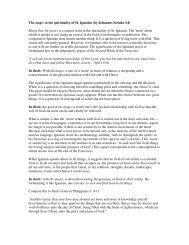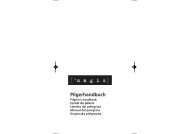Methods for the beginning 1. Clarify the participants' expectations ...
Methods for the beginning 1. Clarify the participants' expectations ...
Methods for the beginning 1. Clarify the participants' expectations ...
Create successful ePaper yourself
Turn your PDF publications into a flip-book with our unique Google optimized e-Paper software.
For a execution in <strong>the</strong> open air: small objects (<strong>for</strong> example of <strong>the</strong> stones, branches etc), to<br />
indicate <strong>the</strong> cardinal points and <strong>the</strong> city where <strong>the</strong> group is.<br />
Preparation<br />
None.<br />
Purpose<br />
They are important that <strong>the</strong> organizer indicates <strong>the</strong> marks clearly, particularly when it is to get<br />
to know each o<strong>the</strong>r, because <strong>the</strong>y require a geographical positioning. Each positioning is<br />
briefly explained - <strong>the</strong> organizer raises questions and possibly summarizes - so that each one<br />
learns how indeed to know something of <strong>the</strong> o<strong>the</strong>rs. It is always necessary to question each<br />
participant. All must take part, also <strong>the</strong> team of organizers, as far as possible. The o<strong>the</strong>r<br />
members of <strong>the</strong> management team of experiment must observe as much as possible and take<br />
note (while keeping <strong>the</strong> supervision). The group must enter a discussion in order to solve <strong>the</strong><br />
task; unless <strong>the</strong> task must be carried out on <strong>the</strong> not-verbal mode. Not to be frightened and not<br />
to give up, if <strong>the</strong> group appears to be slow or if it has problems of comprehension. Simply to<br />
continue to guide. This exercise is appropriate <strong>for</strong> any age!<br />
It can undoubtedly be useful to try out this exercise in your circle of friends, in order to<br />
measure <strong>the</strong> originality of it.<br />
3. Names and gestures<br />
Topic<br />
To get to know each o<strong>the</strong>r, to get <strong>the</strong>mselves moving, to feel its own body.<br />
Intention<br />
The members of <strong>the</strong> group take note of <strong>the</strong> names of <strong>the</strong> o<strong>the</strong>rs and try to follow.<br />
How it is done:<br />
The group is upright in circle. The organizer starts, it says its name clearly and<br />
geste/mouvement does at <strong>the</strong> same time one, which should correspond to<br />
• its state of mind<br />
• its temperament<br />
• its trade<br />
• its origin<br />
• its hobby<br />
(<strong>for</strong> example to curve <strong>the</strong>mselves deeply, imitate <strong>the</strong> play of pianist etc.)<br />
All repeat at <strong>the</strong> same time <strong>the</strong> name and remake <strong>the</strong> gesture.<br />
Duration<br />
Approximately 10 min.<br />
Material<br />
None<br />
Preparation<br />
None<br />
Purpose




